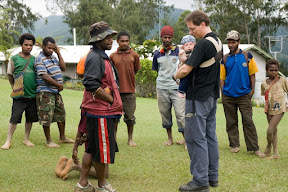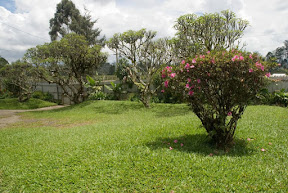Sangapi, Final Report
Sangapi is situated on a hill with a small river running in the valley to the North and East. It consists of houses scattered over a large area, a church and health centre building, as well as government grounds with several buildings and a school.The church and the health centre are built on the ground of a former mission station and were founded by Nazarene missionaries in the 1970’s. This ground also includes several staff houses with gardens, and the airstrip. Everything still belongs to the Nazarene church and is managed by employed locals. Three gardeners tend to the grounds, four medical staff including a health centre manager man the health centre, and a pastor leads the local congregation.
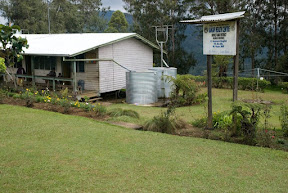 |
| Health Clinic |
The government grounds include soccer and basketball fields, an area where markets are held, a house with rooms for offices and meetings, as well as two staff houses. The school comprises of four classroom buildings, housing for teachers, and a surprisingly large area with several toilet houses for the pupils. The school runs classes for grades 1 to 7 and employs seven teachers, two females and five males. If every student would attend, the school would serve about 150 pupils. However, parents often held their kids back from attending school because they cannot afford to pay for their school fees. Subsidies granted by the government are usually used by the teachers to buy books, stationary or other school supplies or to repair classrooms or their houses.
Some students have to walk several hours to get to school, leaving as early as 6 o’clock in the morning to be on time for school to start at 9 o’clock. If the distance is too big, the children usually stay with relatives living closer to the school, and go home to their village only on the weekends in order to get a new supply of kaukau for the week.
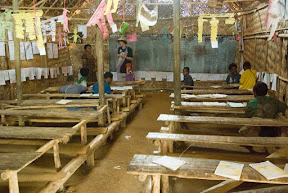 |
| School Room |
There is no road to Sangapi. The only way to access it is by taking public transport to where the road ends, then hike for several days to get to the village. Several jungle paths connect the different villages and areas, so somebody visiting has to walk several hours to get here. We were told that MAF is the only reasonable link to the outside world and thus, very important to them. Things like systematic vaccinations, general and emergency medical help, schooling, and income through coffee sales are only possible through this means of transport. It has to be noted, that the average person is not able to buy a ticked in order to use the plane. However, they profit through a general rising of living standards, especially through schooling and improved health services.
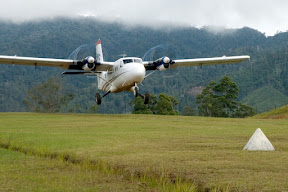 |
| Twin Otter Take-off after bringing back women, who had attended a church women's conference |
Whenever we mentioned that we were working for MAF, the people showered us with their appreciation for MAF’s work and stressed that they had been praying for more pilots for a long time, and thus saw in us an answer to their prayers.
Communication is limited to two radios, one owned by the mission station and the other one by the health clinic. Some nationals have mobile phones, but in order to use them they have to walk one and a half hours to the next ridge, where they can pick up a mobile network. Surprisingly enough some of them seem to do this quite often.
Since Sangapi is not setup in the usual way with a central meeting place, the grounds of the mission station and the government is where people usually meet. The health centre manager organises regular soccer tournaments where six teams from the surrounding region compete. This is also an opportunity for women from the surrounding villages to sell some of their produce.
We were lucky to experience one of those soccer-market Saturdays during our stay.
 |
| Community Grounds |
The government grounds are also the place where official meetings are held. During our stay a “toktok” was held in order to discuss the actions to be taken regarding a recent break-in into one of the teachers houses. Since the discussion was held in their tok ples we couldn’t really follow and the summaries we got were not all consistent.
The local people live in huts made of banana leaves and covered with kunai grass or sometimes corrugated iron. The living quarters usually consist of the main house, a cooking house, and a small toilet building. Since there is no electricity and it gets quite cold after sunset, the main assembly room is the “haus kuk”, where a fire burns. This is even true for the staff living on the station ground, where the houses themselves provide gas stoves, running water, and flush toilets.
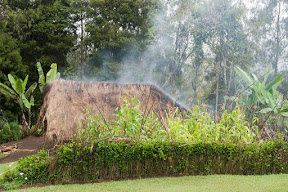 |
| Haus Kuk (Kitchen) |
Everybody lives from what their garden produces. We saw banana trees, sweet potatoes, different greens (kumu), sugar fruits, corn, cabbage, and spring onions. These stables are supplemented by chicken (eggs and meat), pig meat (on rare occasions), and birds that are shot with bow and arrow. However, protein is included very rarely and most of the time “kaukau” and “kumu” are the only foods for supper.
The health centre provides basic medical care for a vast area. On Wednesday night a woman, who had broken her leg, was carried in from a remote place on a stretcher. Her condition was critical, since the bone stuck out of her leg and she had lost quite a bit of blood, so the health centre manager contacted Kujip Hospital via radio in order to get advice and request a medical evacuation for the next morning. The medivac, however, had to be postponed to Friday due to bad weather. During our stay the health centre also treated soars, cuts with bush knives, and severe diarrhea in a child. Even so the hospital staff encourages women to come to the hospital for delivery, they usually only come when there are complications.
Apart from treating medical emergencies, the health centre manager also tours the surrounding area in order to visit different houses and villages, as do the two nurses. During these tours the manager mainly does vaccinations for children, whereas the nurses teach mothers about basic hygiene, nutrition and family planning issues. Since there are no roads, everything is done on foot with all the supplies being carried, including portable eskies to keep the vaccines stored at the right temperature. While out in the villages, the hospital staff are provided with food and shelter by the recipients of their care.
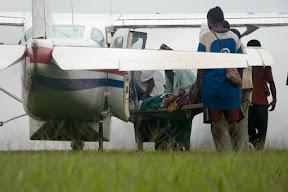 |
| Medevac with a Cessna 206 |
The church has an attendance of about 120 people, again coming from all the surrounding area. Sunday sermons are usually held in the local language, but are sometimes translated into Pisin for the benefit of those with a different “tok ples”. The pastor, too, does a lot of travelling while visiting people of the congregation.
 |
| Church Bell |
We were told that the Nazarenes had eradicated most of the local traditions. However, in a region further to the West where the Anglican Church is predominant, old customs are still observed. Boys of a certain age, for example, still wear a bilum over their head for two years. During this time this is their only clothing and they do not wash. This, together with other things, forms part of their initiation rite.














